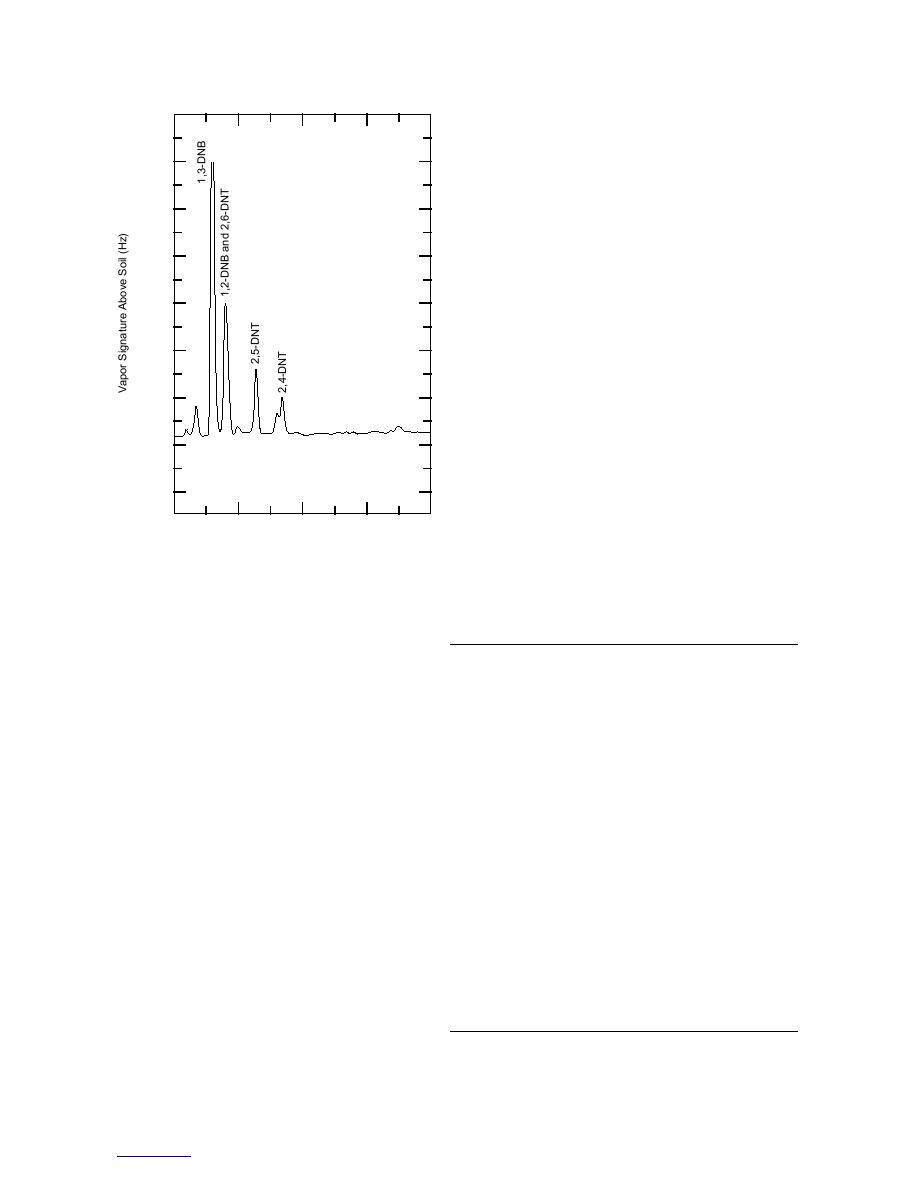
were similar, though, for the mid- and high-mois-
1,600
ture levels for all three soils.
Sand
Overall, these results demonstrate that the
12C
1,400
Low Moisture
qualitative nature of the vapor signature above
36 Days
buried military-grade TNT depends on the envi-
ronmental conditions present in the soil, namely
1,200
soil temperature, soil type, and soil moisture con-
tent.
1,000
Calibration of SPME fibers for quantification
of analytes in headspace samples
800
SPME fibers were used in this study because of
their ability to provide an enormous preconcen-
tration of explosives-related vapors, and to effi-
600
ciently transfer these collected vapors to the injec-
tion port of a gas chromatograph. This precon-
400
centration is necessary because the concentration
of headspace vapors above buried military-grade
TNT is expected to be very low. For example, Jen-
200
kins et al. (1974) measured concentrations of TNT
in headspace vapors above buried TNT in the
range of 1011 to 1013 g/mL. While the ECD
0
detector is very sensitive and can detect less than
4
5
6
7
8
Time (min)
Table 6. Analyte mass (pg) collected in 1 minute from
Figure 5. Vapor signature above low-moisture sand
headspace vapor using SPME above soils containing
held at 12C for 36 days.
buried U.S. military-grade TNT, at 23C, and three
moisture levels after 6 days of equilibrium.
because these two samples involved different
Soil
Rep A
Rep B
Rep A
Rep B
Rep A
Rep B
exposure periods for the SPME fibers.
Figure 5 presents the GC-ECD chromato-
Sand
Air dry
2.1% moisture
3.1% moisture
1,3-DNB
29.3
41.2
561
433
285
289
gram from the SPME fiber corresponding to
1,2-DNB
16.5
21.1
106
79.2
57.9
59.8
the headspace vapor above TNT buried in Ot-
2,5-DNT
2.34
<d*
61.6
<d
35.9
37.9
tawa sand for 36 days, but held at 12C. In
2,4-DNT
2.36
3.93
754
600
441
497
this case, the peaks corresponding to the TNT
3,5-DNT
<d
d
175
<d
108
119
isomers are no longer visible, and even the
1,3,5-TNB
<d
<d
<d
<d
<d
<d
2,4,6-TNT
0.267
0.305
20.8
14.9
13.7
32.8
peak corresponding to 2,4-DNT, the most
abundant peak at 4C, is reduced relative to
Silt
Air dry
5.8% moisture
10% moisture
those for the more volatile isomers of DNB.
1,3-DNB
<d
<d
59.4
64.9
49.7
51.4
1,2-DNB
<d
<d
8.80
50.5
8.40
8.44
Thus, soil temperature is an important factor
2,5-DNT
<d
<d
2.50
15.6
1.91
1.85
in the modification of the qualitative nature of
2,4-DNT
0.145
0.274
49.7
131
51.4
51.3
the vapor signatures above buried military-
3,5-DNT
<d
<d
15.8
27.2
15.4
15.0
grade TNT.
1,3,5-TNB
<d
<d
<d
<d
<d
<d
Table 6 shows the effects of soil type and
2,4,6-TNT
0.652
0.807
1.59
1.71
1.54
1.83
moisture content on headspace vapors. Con-
Clay
Air dry
15% moisture
30% moisture
centrations of the various nitroaromatics are
1,3-DNB
<d
<d
2.34
2.24
2.29
1.64
about an order of magnitude higher over sand
1,2-DNB
<d
<d
1.19
1.31
1.22
1.00
2,5-DNT
<d
<d
<d
0.054
<d
<d
than silt and about two orders of magnitude
2,4-DNT
<d
<d
<d
<d
<d
<d
higher than over the clay. Large differences are
3,5-DNT
<d
<d
†
†
†
†
also apparent between moist and air-dried
1,3,5-TNB
<d
<d
<d
<d
<d
<d
soil, regardless of soil type. Generally, the
2,4,6-TNT
<d
<d
<d
<d
<d
<d
vapor concentrations over moist soils are an
* Below detection level.
order of magnitude or more higher than over
† An interference precluded determination of 3,5-DNT in these
air-dried soils. The headspace concentrations
samples.
7
To Contents



 Previous Page
Previous Page
